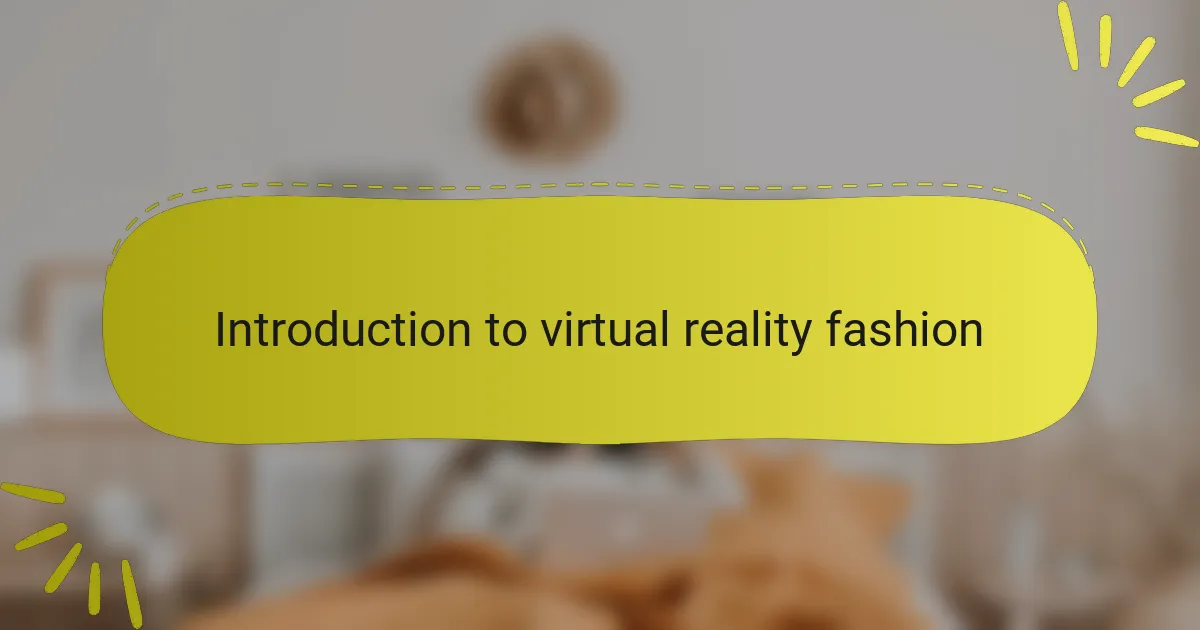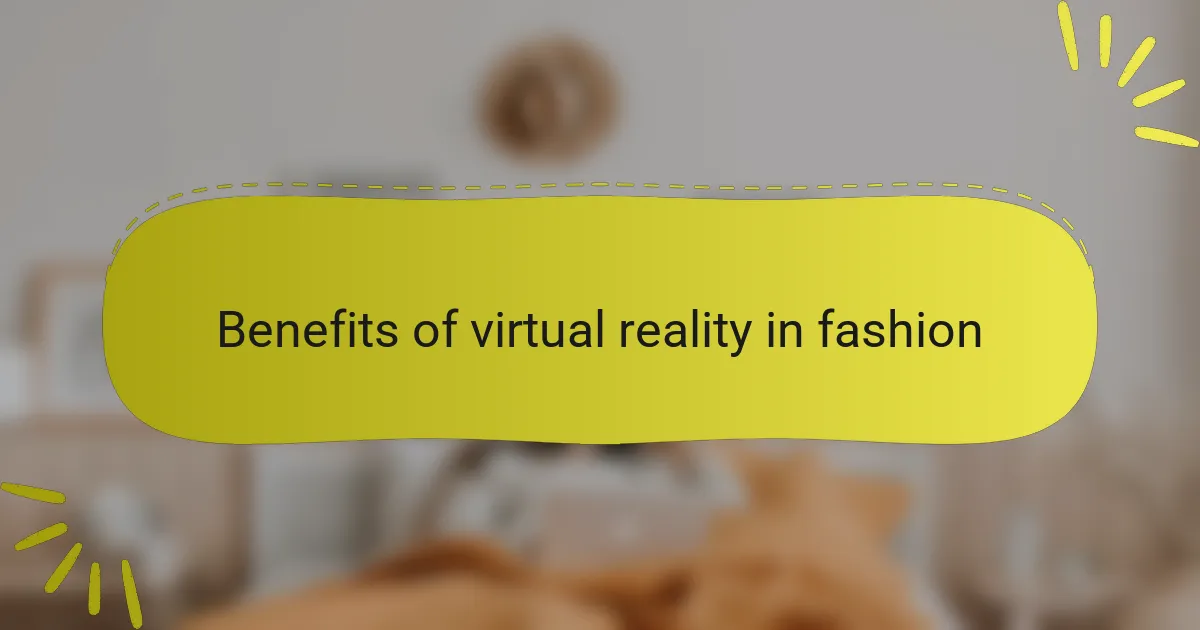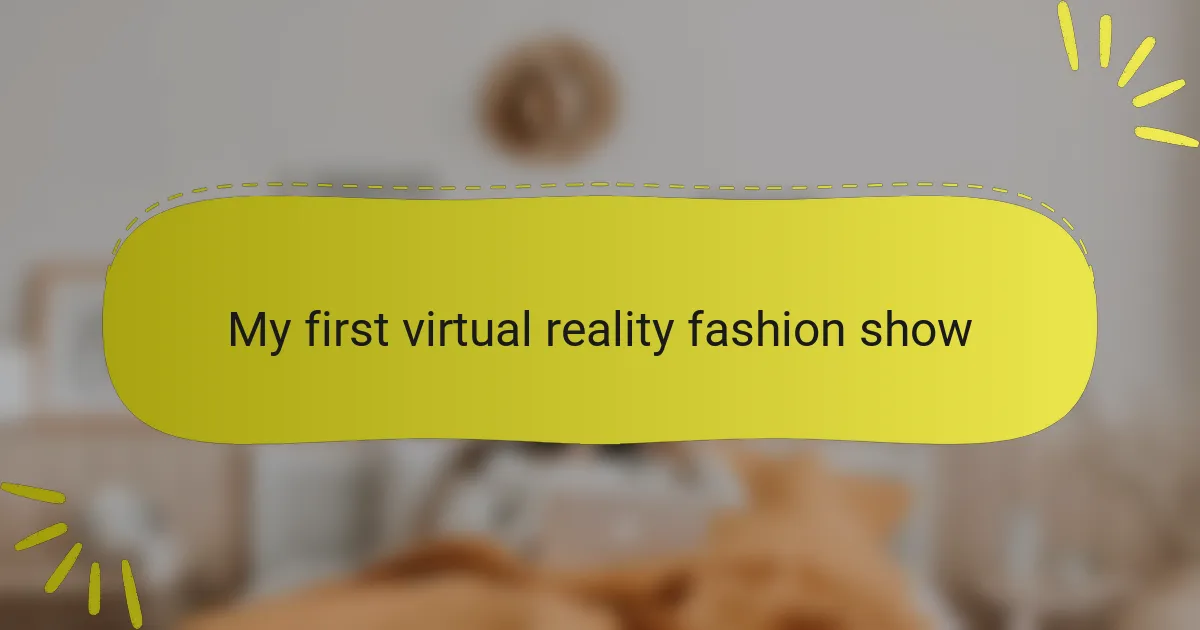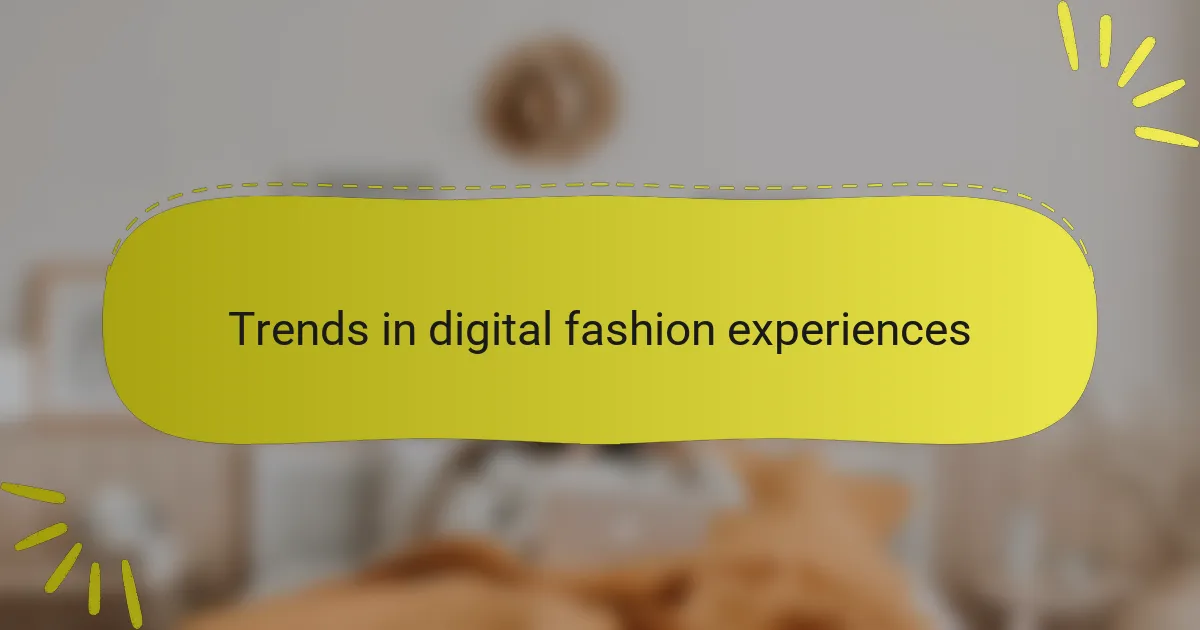Key takeaways
- Virtual reality (VR) fashion shows enhance accessibility and interactivity, allowing a global audience to engage with designs from multiple perspectives.
- Digital fashion magazines offer immersive content and direct engagement with brands, transforming the way fashion is experienced compared to traditional print.
- The future of VR in fashion promises increased personalization, inclusivity, and sustainability, potentially democratizing access to the fashion industry.
- VR creates a deeper emotional connection to fashion, enabling viewers to appreciate the artistry and narratives behind collections more intimately.

Introduction to virtual reality fashion
Virtual reality (VR) fashion shows represent a fascinating fusion of technology and creativity. I’ve always been passionate about fashion, and experiencing a show in VR was nothing short of transformative. Walking through a digital runway where every detail is heightened made me feel like I was part of a unique, immersive world.
The ability to experience designs from every angle and interact with them in a virtual space is a game changer. I remember being mesmerized by the textures and colors, which felt even more vibrant in VR. It’s more than just watching a collection; it’s an experience that connects you intimately to the garments and the vision behind them.
Here’s a comparison of traditional fashion shows versus virtual reality fashion shows:
| Aspect | Traditional Fashion Shows | Virtual Reality Fashion Shows |
|---|---|---|
| Accessibility | Limited to in-person attendees | Accessible to a global audience |
| Experience | Visual from a fixed perspective | Immersive experience with 360-degree views |
| Interactivity | Minimal interaction | High level of interaction with virtual garments |
| Cost | High production costs | Potentially lower costs for broader reach |

Overview of digital fashion magazines
Digital fashion magazines have profoundly transformed the way we experience fashion. With lush visuals and interactive content, they offer a fresh perspective that traditional print couldn’t quite capture. I remember my first encounter with a digital fashion magazine; it felt like stepping into a vibrant gallery where each page turned into an experience.
These platforms not only showcase incredible designs but also enable readers to engage with brands directly. I often find myself lost in the immersive stories behind collections, gaining insights that inspire my own style. Digital fashion magazines are no longer just publications; they are dynamic communities where creativity thrives.
| Feature | Traditional Fashion Magazines |
|---|---|
| Format | |
| Interactivity | Limited |
| Instant Updates | No |
| Access to Designers | Limited |
| Cost | Higher |
| Engagement | Passive |
| Format | Digital |
| Interactivity | High |
| Instant Updates | Yes |
| Access to Designers | Direct and Immediate |
| Cost | Lower or Free |
| Engagement | Active |

Benefits of virtual reality in fashion
Virtual reality (VR) in fashion is more than just a trend—it’s a transformative experience. I remember my first VR fashion show; it was like stepping into a dream where I could virtually walk the runway alongside my favorite designers. This immersive environment allows viewers to connect with the clothing on a deeper emotional level, enhancing their appreciation for the artistry involved.
The benefits of virtual reality in fashion are numerous and compelling:
- Enhanced Experience: VR lets designers showcase their collections in imaginative settings, making the viewing experience dynamic and memorable.
- Accessibility: Attending a physical fashion show can be exclusive; VR opens the door for fans worldwide to participate without geographical limitations.
- Interactive Engagement: Viewers can interact with the garments and accessories, enabling a connection that traditional media simply can’t offer.
- Sustainable Solution: It reduces waste from physical runways and samples, aligning with the growing demand for sustainable fashion practices.
- Creative Freedom: Designers can push boundaries and create experiences that challenge traditional concepts of fashion presentation.
Through VR, I’ve found a new appreciation for how fashion can blend technology with artistry, and I truly believe this medium is just the beginning of a more inclusive and innovative future.

My first virtual reality fashion show
Attending my first virtual reality fashion show was an unforgettable experience. As I slipped on my VR headset, I felt a rush of excitement and curiosity. The moment I entered the virtual venue, I was transported into a vivid world buzzing with creativity and innovation. The models glided down the runway, showcasing stunning digital garments that challenged traditional fashion norms.
I vividly remember the feeling of being part of something groundbreaking. I could almost reach out and touch the fabrics, which seemed to shimmer and change with every movement. It felt surreal, yet truly captivating, as I could interact with the designs and even explore the virtual showroom afterward.
Here’s a comparison of my expectations versus the reality of attending a virtual fashion show:
| Expectations | Reality |
|---|---|
| Traditional runway format | Immersive 3D environment |
| Limited audience experience | Global participation with avatars |
| Static garment displays | Dynamic digital designs |

Insights from attending virtual shows
Attending virtual shows opened my eyes to a whole new dimension of fashion. One thing that struck me was the sheer range of perspectives I could explore. I remember adjusting my view and finding myself mesmerized by a digital garment that looked completely different from another angle. It was an exhilarating moment, making me ponder: How often do we truly see the layers of creativity in fashion from a static viewpoint?
The interactivity also blew me away. Being able to click on a garment to learn more about its design process was like sitting down for a chat with the designer. I recall a moment when I engaged with a digital piece, and the background story unfolded before my eyes. This kind of connection is rare in traditional shows, where we often miss the narrative behind the pieces.
Finally, the insight into inclusivity was profound. As I looked around, I saw avatars from all over the world, each participant experiencing the show simultaneously. It made me reflect: Isn’t it remarkable how virtual reality breaks down barriers and invites everyone into the fashion conversation? This collective experience added a richness that went beyond mere observation.

Trends in digital fashion experiences
The realm of digital fashion is evolving rapidly, and one of the most exciting trends I’ve encountered is the integration of virtual reality (VR) into fashion shows. These experiences allow designers to showcase their collections in immersive environments, providing a unique emotional connection for their audience. I remember attending a recent VR fashion show where the ambiance transported me into a vibrant, otherworldly setting—it truly felt like walking into the designer’s imagination.
Another notable trend is the blending of social media with virtual experiences, allowing for interactive participation. I found it fascinating how attendees could engage in real-time, even influencing the show as it unfolded. This level of interactivity made me feel like I was part of something larger than just an audience; it was as if I was co-creating the experience, which was exhilarating.
Here’s a simple comparison of traditional versus virtual reality fashion shows:
| Aspect | Traditional Fashion Show | Virtual Reality Fashion Show |
|---|---|---|
| Location | Physical venue | Digital environment |
| Audience Interaction | Limited engagement | Real-time participation |
| Accessibility | Restricted to attendees | Global access |

Future of virtual reality fashion shows
The future of virtual reality fashion shows is brimming with possibilities that I find incredibly exciting. As technology advances, I envision shows becoming even more interactive and personalized. Imagine attending a VR fashion show where the collection is tailored to your preferences, and models walk the runway wearing your virtual outfits. Wouldn’t that create a sense of ownership and connection with fashion that we’ve never experienced before?
I also believe that as VR technology becomes more accessible, we’re likely to see an influx of diverse voices in fashion. I remember being captivated by a show that celebrated underrepresented designers, giving them a platform to shine on an equal footing. It’s thrilling to think that VR can democratize the fashion industry, allowing talent from around the globe to share their unique visions and stories. How can we not look forward to a future where fashion isn’t confined to a select few?
Moreover, sustainability will likely play a significant role in shaping the future of these virtual experiences. I’ve often felt a pang of guilt about the environmental impact of traditional fashion shows. With VR, we can reduce waste and offer an eco-friendly alternative. It dawned on me that this shift could pave the way for a more conscious industry, one that resonates with our growing desire for responsible fashion. Isn’t it inspiring to think that we could be part of a movement that prioritizes both creativity and sustainability?